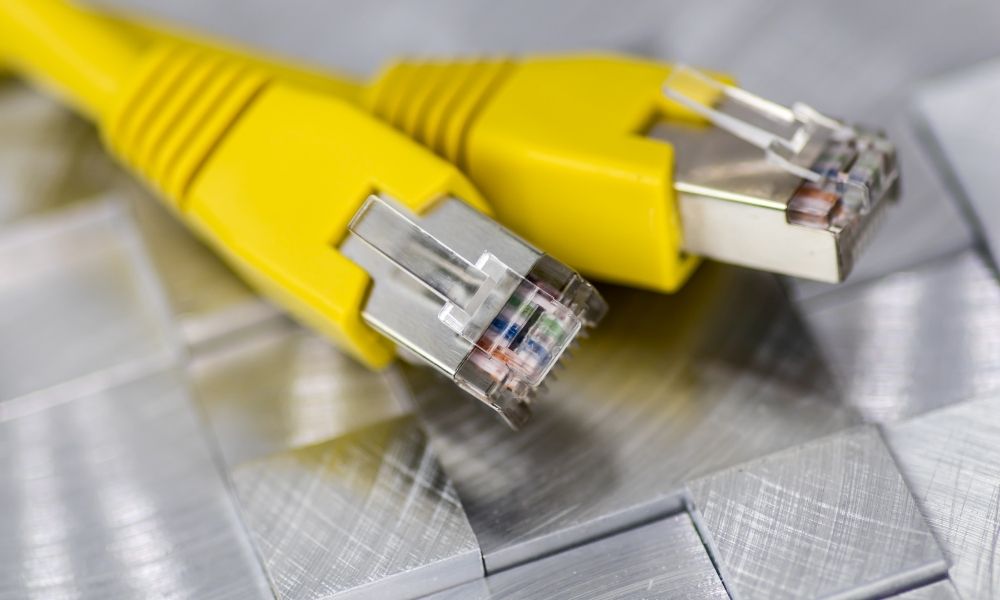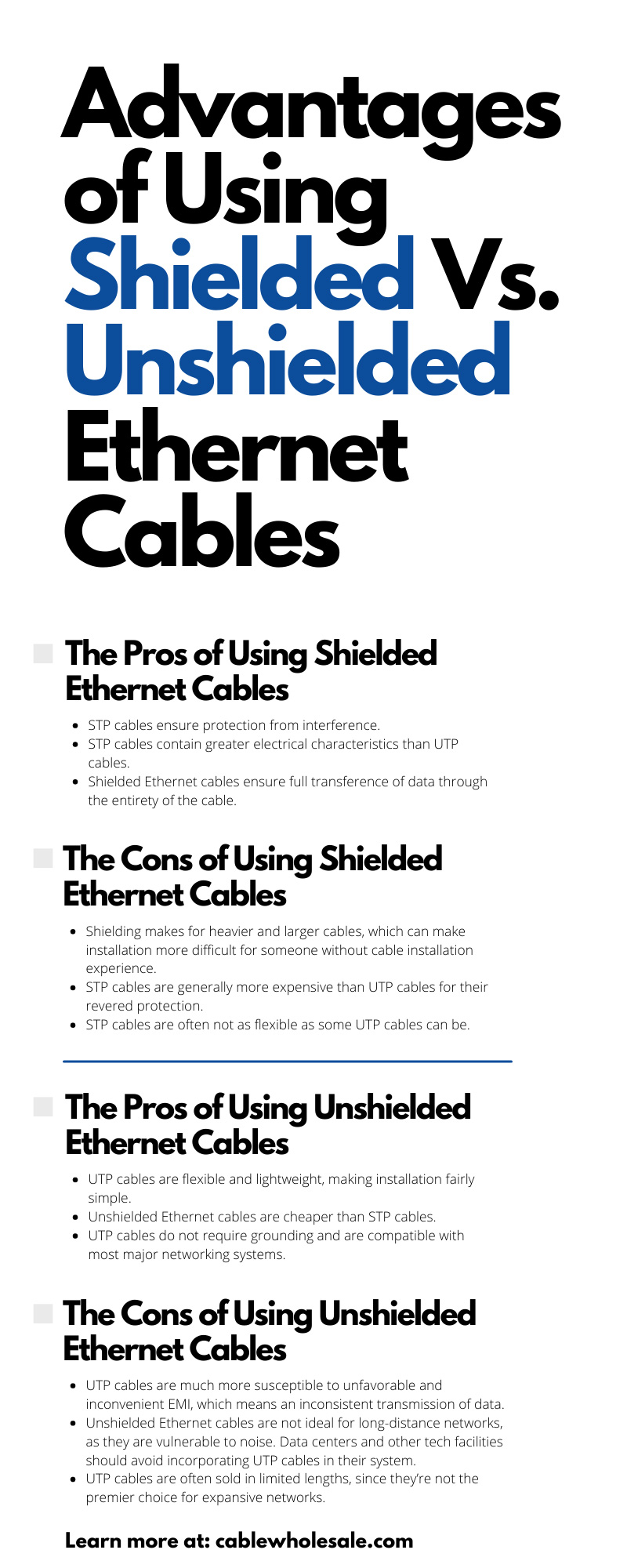
When it comes to setting up your computer network system, there are tons of options for hardware, cables, and all kinds of equipment. The abundance of decisions to make while organizing your setup can be overwhelming, especially if you don’t have any experience with computer systems. However, optimizing your network doesn’t have to be all that complicated. In this article, we’ll look at one vital component to a well-running wired network: the Ethernet cable.
Just like any other component of a complete computer system, you have a slew of Ethernet cable options to choose from. For the sake of finding the right cord for your setup, we can categorize Ethernet cables into two separate categories—shielded and unshielded. CableWholesale reflects on the advantages of using shielded vs. unshielded Ethernet cables. Upon reviewing our comprehensive list of pros and cons between the two, you’ll have a much better understanding of how these Ethernet cables function and feel much more confident in selecting cable bundles that are optimal for your system.
Main Categories of Ethernet Cables
It’s important to distinguish the differences between Cat5e, Cat6, and Cat6a Ethernet cables, as you can purchase any one of them as shielded or unshielded. To start, narrow down your Ethernet cable option by determining which “Cat,” or category, cable will do the job.
Cat5e
An evolved version of Cat5 cables, Cat5e Ethernet cords have reduced crosstalk, leading to a less disruptive connection to your internet. Commonly, people peruse Cat5e cables for sale when looking to fulfill basic connectivity needs at home.
Cat6
Cat6 Ethernet cables can perform throughout expansive business infrastructures. Cat6 cables are convenient for folks looking to upgrade their cables for Cat5e and Cat5 compatible devices, as Cat6 Ethernet cords will still fit with these older devices.
Cat6 cords are also effective at reducing crosstalk due to the plastic separator spine integrated inside. This separator also contributes to greater speed.
Cat6a
A grade above Cat6 cables, Cat6a Ethernet cables support 10 Gbps and can do so for up to 100 meters of cable. Because you can cover so much ground with Cat6a cables, you’ll need ample protection against EMI. This is why you’ll find most Cat6a cables with a shielded structure to protect against electromagnetic interference.
The Difference Between Shielded and Unshielded Ethernet Cable Structures
Now that you’re aware of the differences between Ethernet cable categories and which one may be right for your connection needs, it’s time to check out the difference between shielding and unshielded Ethernet cable structures. Understanding how they’re composed can provide a better understanding of what promotes the advantages of using shielded vs. unshielded Ethernet cables and their disadvantages, too.
The Structure of Shielded Ethernet Cables
Shielded cables, or shielded twisted pair (STP) cables, contain conductive materials to provide maximum coverage from noise that would hinder your connection. Materials such as mesh or aluminum foil get wrapped around twisted wire pairs, which are then contained within a cable jacket.
The Structure of Unshielded Ethernet Cables
As you can likely infer from their name, unshielded Ethernet cables do not have the additional outer shielding that STP cables do. UTP cables are still contained by an outer jacket, but unshielded twisted pairs rely on the way that the wire pairs are twisted inside of the cable to protect them against electromagnetic interference.
If you were to cut into an unshielded cable, you wouldn’t find any additional mesh or foil wrapped around the wires. Because of their structure, UTP cables are often lighter and cheaper than STP cables.
The Pros of Using Shielded Ethernet Cables
The way shielded Ethernet cables are structured contributes to many reasons why these cables are advantageous to both business owners and homeowners in need of a reliable connection. Let’s look at the advantages that STP cables have over UTP cables.
- STP cables ensure protection from interference. The conductive material that wraps around the interior wires either reflects or conducts external noise away in a fashion that doesn’t disrupt the internal conductor’s signals.
- STP cables contain greater electrical characteristics than UTP cables.
- Shielded Ethernet cables ensure full transference of data through the entirety of the cable. EMI exposure is especially present in data centers, company offices, industrial settings, and other spaces where there’s a large volume of electrical equipment. Without safeguarded cables, there’s no guarantee that you’ll be able to transmit your data without problems occurring regularly.
The Cons of Using Shielded Ethernet Cables
Though the advantages of shielded Ethernet cables are enticing, it’s essential to consider the bad alongside the good. Below are the flaws of STP cables.
- Shielding makes for heavier and larger cables, which can make installation more difficult for someone without cable installation experience.
- STP cables are generally more expensive than UTP cables for their revered protection.
- STP cables are often not as flexible as some UTP cables can be.
The Pros of Using Unshielded Ethernet Cables
While UTP cables may not have conductive materials, they still have the following advantages.
- UTP cables are flexible and lightweight, making installation fairly simple.
- Unshielded Ethernet cables are cheaper than STP cables.
- UTP cables do not require grounding and are compatible with most major networking systems.
The Cons of Using Unshielded Ethernet Cables
Check out which flaws make some folks choose STP cables over unshielded Ethernet cords.
- UTP cables are much more susceptible to unfavorable and inconvenient EMI, which means an inconsistent transmission of data.
- Unshielded Ethernet cables are not ideal for long-distance networks, as they are vulnerable to noise. Data centers and other tech facilities should avoid incorporating UTP cables in their system.
- UTP cables are often sold in limited lengths, since they’re not the premier choice for expansive networks.
So, Are Shielded or Unshielded Cables Better?
Where and how you intend to use your cables should heavily influence your decision to go with either shielded or unshielded Ethernet cables. As mentioned, larger facilities with lots of technical equipment, such as hospitals, data centers, radio stations, and airports, benefit from the advantages of STP cables. However, where minimal EMI is present, the use of unshielded Ethernet cables should suffice. You can sustain your home or a smaller office with UTP cables and your connection should work just fine.
Regardless of your preference, CableWholesale provides both STP and UTP cables of every main category Ethernet cable. Check out our expansive inventory online or give us a call to learn more about our eclectic selection of cables and cable management accessories.




